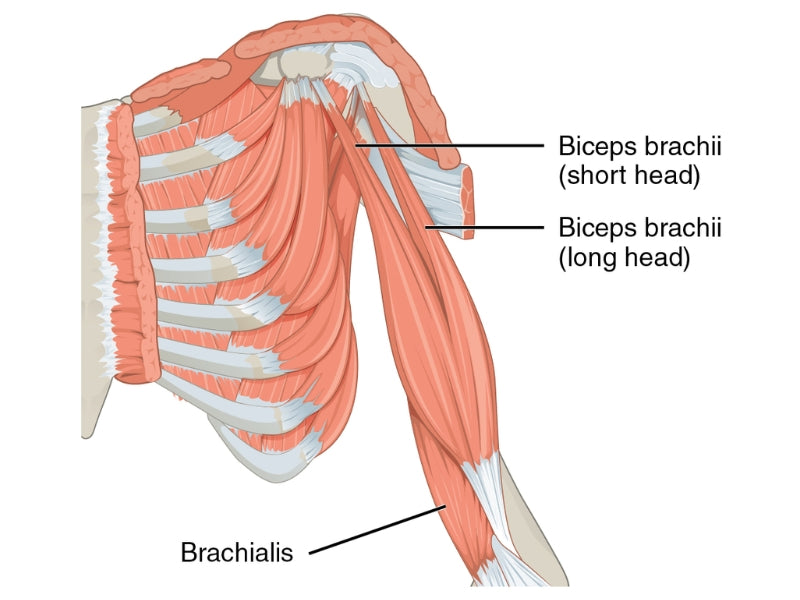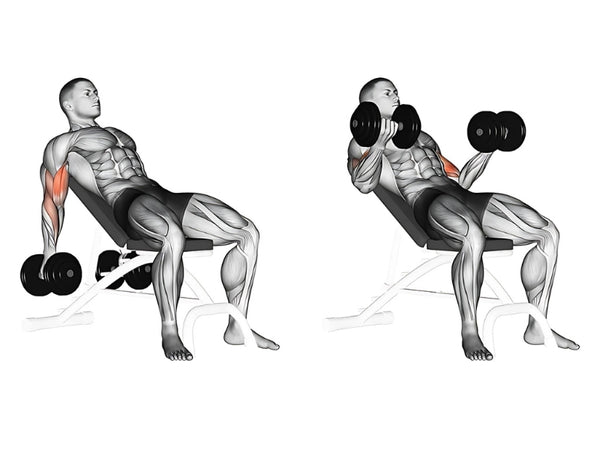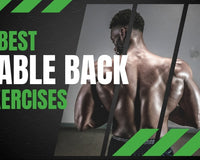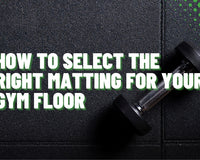If you want to impress people when you flex your biceps, you need to know which section to target. Sure, the short head of the bicep is important to provide some thickness to your arm when it's not flexed.
However, when you flex your arm, it's the long head that sticks out, and it's the long head that creates those big peaks that you're looking for.
What we want to do today is to take a look at the 8 best long head bicep exercises so you can grow those peaks. We'll start with a bit of basic information and then get right to the best exercises to target the long head of your biceps.
The Biceps Brachii 101 – Anatomy & Function

Your bicep, otherwise known as the bicep brachii, is one muscle located on the upper arm, the anterior side, and it's divided into two heads, the long head and the short head. Having different heads means that they are attached at different points on your arms.
If you want those big peaks when you flex your biceps, it's the long head you need to target.
Both muscles feature different starting points, but they converge at the same point, otherwise known as the same muscle belly, which is along the upper arm near the forearm.
While the short head is found on the inner side of the upper arm, the long head is found on the outer side and the top of the anterior upper arm.
Together, the long head and short head of the bicep allow you to flex the elbow and bring your wrist towards your shoulders, or in other words, your forearm towards your upper arm.
Your biceps are also responsible for rotating your arm outward, otherwise known as supination.
Because both the long and short heads of the biceps cross the shoulder joint, they help with both abduction and adduction of the shoulder joint, as well as shoulder flexion.
Isolating the Biceps Brachii Long Head – Is It Possible?
As mentioned above, the long head is just one-half of your bicep, with the short head being the other half.
Because both come together to form a single muscle, it's not possible to fully isolate one from the other.
However, there are certain tips you can follow, such as the ones listed below, that shift the focus onto the long head over the short head.
Best Ways to Target the Long Head of the Biceps Brachii
There are four main methods you can use to help target the long head of your bicep over the short head.
- Use a hammer grip, otherwise known as a neutral grip, which sees your hands or palms facing inwards.
- Use a close grip with your hands as close together as possible.
- Doing curls with your elbows out behind you as far as possible.
- Doing curls with your elbows tucked firmly in at your sides.
If you are also looking for ways to target the short head of the biceps, take a look at our short head biceps exercise guide.
The 8 Best Long-Head Bicep Exercises to Grow Huge Peaks
Now that we've covered all of the basics about the bicep muscle, specifically the long head of the bicep, it's time to take a look at some of the best exercises that you can do to target this part of your bicep.
1. Neutral Grip Pull-Ups
Although most people might see the pull-up as an exercise that helps target the lats, shoulders, and upper back, it's also a great bicep exercise.
The reason why we're talking about a neutral grip pull-up is because as we mentioned above, this grip position is best for targeting the long head of your biceps.
You don't want to use a wide grip for this exercise, because you end up using your lats a lot more than your biceps.
An interesting note is that you'll be able to lift yourself up much more easily doing a neutral grip pull-up than with a regular pull-up.
For this exercise, you're going to need a pull-up bar that has parallel handles to allow for that neutral grip.
How To Do Neutral Grip Pull-Ups
- Hold the parallel handles so that your hands are in a neutral position and hang down from the bar.
- While squeezing your shoulder blades in and down, known as scapula protraction, use your biceps, and if necessary your lats, to pull yourself up as high as possible, ideally up to your chest.
- When you're at the top of the motion, squeeze your biceps as much as you can and then slowly return down to your starting position.
2. Close Grip Chin-Ups
Yes, we know that lifting your whole body up is fairly difficult to do, but because of this, it's also one of the best ways to activate your biceps and to get the most stretching and contraction in.
If you want to target the long head of your biceps, doing a close grip chin-up is another great option.
It's pretty similar to the neutral grip pull-up that we already discussed, but with a chin-up, the range of motion is much more pronounced and wider, combined with that narrow grip, which allows for maximum long head bicep activation.
Keep in mind that once you can do 10 reps and three sets without much trouble, adding something like a weight belt to add more resistance to the mix is ideal.
How To Do Close Grip Chin-Ups
- With an underhand grip and your hands close together, hold the pull-up bar.
- Let yourself hang down from the bar and squeeze your shoulder blades in and down, and then use your biceps primarily to pull yourself up as high as possible. Ideally, you want to raise yourself to the point where your chest touches the bar.
- At the top of the motion, really squeeze your biceps, and then lower yourself back down until your arms are extended fully.
3. Hammer Curls with Dumbbells
Doing a dumbbell hammer curl is not only a great way to help grow your biceps and forearms, especially as far as the long head of the bicep is concerned. That neutral grip that the hammer curl involves is a great way to target the long head.
Although dumbbells are the most common piece of equipment to do this exercise, it is also possible to use a cable machine using a rope attachment.
It is possible to do hammer curls both sitting and standing, with the seated position being best to prevent you from cheating as it keeps your farm strict. Furthermore, you can choose to curl both arms simultaneously or alternately.
How To Do Dumbbell Hammer Curls
- Sit on a bench with your back firmly against the backrest, so that your upper body is vertical.
- Hold a pair of moderately heavy dumbbells, stretch your arms downwards at your sides, keep your elbows close to your body, and use a neutral grip, which means that your palms should be facing inward.
- While keeping your elbows in place, curl the weight upwards while maintaining that neutral grip.
- Squeeze at the top of the motion, and then slowly release and return to the starting position as slowly as possible, making sure to fully extend your arms.
Related: Hammer curls are also a great choice for any Forearm Workout with Dumbells.
4. Close Grip Preacher Curls
Now, most people would say that the preacher curl is best for targeting the short head of the bicep, which is true to a certain extent because it keeps your elbows out in front of you. However, also remember that having a close grip is ideal for targeting your long head.
Therefore, if you do a preacher curl with a close grip, it's going to target both heads of your biceps. Something that many people also like about the preacher curl is the fact that it keeps your arms completely steady, therefore preventing you from using your shoulders or upper back to gain leverage and effectively cheat during the curl.
A great piece of advice here is to fully extend your arms when returning to the starting position, as this puts a lot of tension on the long head, with maximum activation always being the goal.
On that note, using the hammer curl position with your palms facing inward when doing preacher curls works to that end.
How To Do Close Grip Preacher Curls
- Sit at a preacher bench and make sure that your arms, all the way from your armpits to your elbows, are resting firmly on the bench. This will help prevent you from cheating. Your forearms shouldn't be touching the pad, but your elbows should.
- Using an EZ Bar (or just the included bar if it’s a preacher curl machine), hold it with as close a grip as possible. Start the exercise with your arms extended.
- Using as much explosive force as you can muster, curl the weight upwards until your forearms are perpendicular to the ground, and squeeze your biceps as much as you can at the top of the motion.
- In a slow and controlled manner, return down to the starting position and fully extend your arms until you feel your biceps stretch.
5. Incline Dumbbell Curls

Doing incline dumbbell curls with a bench is a great way to target the long head of your bicep. This is because it keeps your elbows down at your sides and behind you, which helps to stretch out the long head, allowing for maximum activation, which is also true thanks to this movement involving the rotation of the forearm from the neutral to the supinated position. It also allows for a large range of motion.
How To Do Incline Dumbbell Curls
- Sit on a bench with the backrest adjusted anywhere from a 45° to a 60° angle, and sit down on it with your back flat against it.
- Hold a dumbbell using a neutral grip, allowing your arms to hang down.
- Curl the weight upwards as far as possible while keeping your elbows in the same position, and during the movement, rotate the forearms so that the palms face upwards, which is a supinated position.
- At the top of the motion, your upper arms should be vertical or perpendicular to the ground.
- Slowly release and return to the starting position, and aim for anywhere between 8 and 12 reps, for up to four sets.
6. Bayesian Curls

Here we have a very special type of curl that works much in the same way as an incline dumbbell curl. Although, instead of using dumbbells, here you're going to be using a cable machine, and you'll be standing up during this exercise.
The trick with this exercise is that you start with your arms stretched out behind you, with your elbows as far back and behind your torso as possible.
What many people like about this exercise, specifically about using the cable pulley machine, is that it produces constant tension, therefore increasing the amount of resistance you feel, especially when compared to a dumbbell, which is not consistent.
How To Do Bayesian Curls
- Go to a cable pulley machine and adjust the pulley to its lowest position.
- Attach a regular stirrup handle to the pulley, and hold it using an underhand grip.
- Stand facing away from the machine with your arm comfortably extended behind you, keeping your arms straight and your elbow as far back as possible. Make sure that your palms face forward.
- From this starting position, curl the cable while keeping your elbows fixed in place and as far back as possible.
- At the top of the motion, contract and squeeze as much as you can, and then slowly return to the starting position.
7. Close Grip EZ Bar Curls

Remember that the closer your grip is on a bar, the more the long head of your biceps will be activated. This is a great exercise because it allows for a lot of shoulder internal rotation, which helps to target the long head.
Now, for these close-grip curls, an EZ bar is generally best, because it allows for a more natural and ergonomic position, although you can also use a regular barbell. You may also use dumbbells with your arms supinated as well.
Now, an interesting fact is that the majority of your biceps consist of fast-twitch muscle fibers, which means that they respond the most to heavy loads and low reps. However, we still recommend aiming for the maximum amount of reps for the most growth possible.
How To Do Close Grip EZ Bar Curls
- Using a close grip, hold the EZ bar or barbell while keeping your back vertical and your feet at shoulder width.
- While keeping your elbows fixed in place, curl the bar upwards as high as possible, and at the top of the motion, contract your biceps as hard as you can.
- For some extra activation, lift your elbows up just a little bit at the top of the motion, squeeze even harder, and then slowly return back to the starting position.
8. Drag Curls

If you really want to isolate the long head of your bicep, then doing a drag curl is worth trying.
Because of the way that your elbows pull back and behind you when you do this type of curl, it really stretches out the long head, allowing for a great deal of activation.
This is a position that also really allows you to contract the muscle as much as possible, which is a great way to build those bicep peaks. This is a great exercise as well because you can use an EZ bar, dumbbells, or barbells.
How To Do Drag Curls
- To do a drag curl, start by holding dumbbells with an underhand grip at shoulder width apart so that the dumbbells are perfectly aligned with your shoulders. Keep your chest puffed out and your back straight.
- Flex your arms at the elbow and curl the weight upwards while also pushing your elbow backwards in a slow and controlled manner. The dumbbells should therefore move straight upwards in a fixed motion.
- Try to raise the dumbbells as high as possible, because the higher you go, the further back your elbows go, allowing for maximum contraction and activation.
- At the top of the motion, squeeze your biceps as much as you can, and then slowly return to the starting position so that your arms are extended fully at your sides.
Related post: Dumbbell biceps exercise guide
The Long and Short of Long Head Bicep Exercises

The most important thing to remember if you want to target the long head of your bicep is to maintain a neutral and inward grip, hold your hands close together in a close grip position, and curl with your elbows out behind you.
If you follow these three main tips, targeting the long head of your biceps to grow those peaks should be a piece of cake.





